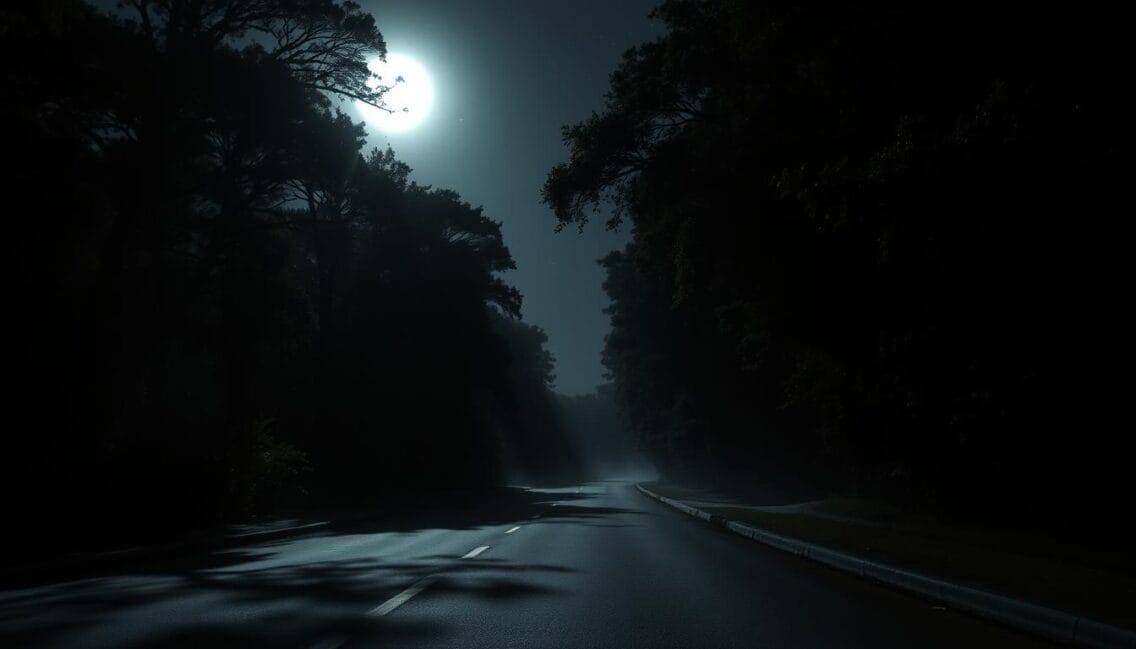The White Lady of Balete Drive

In Manila, a legend has caught everyone’s attention – the White Lady of Balete Drive. This ghost story has been around for decades. It started in the mid-1950s, when Balete Drive was a quiet street in Quezon City.
The story is about a young woman, called the “Kaperosa.” She died under tragic circumstances on this road. People say her ghost, dressed in white, looks for her killer. Taxi drivers and locals have seen her, adding to the legend.
So, why is Balete Drive so famous for this ghost story? Exploring its history and geography reveals a lot. It shows why this street is a key part of the Philippines’ ghost stories.
Key Takeaways
- Balete Drive in Manila, Philippines is known for its urban legend of a white lady ghost haunting the street.
- The legend dates back to the 1950s when the street was poorly lit and lined with large balete trees.
- The ghost, known as the “Kaperosa,” is said to be the spirit of a young woman who was killed in a hit-and-run accident on the street.
- Sightings of the white lady have been reported by taxi drivers and residents, inspiring various film adaptations of the legend.
- The history and geography of Balete Drive contribute to the enduring popularity of the white lady ghost story in the Philippines.
History of Balete Drive: From Spanish Era to Modern Times
Balete Drive in Quezon City, Philippines, has a rich history. It goes back to the Spanish colonial era and continues to today. The street was named after a big balete tree that stood in the middle. This tree was important in Philippine folklore and culture.
Origins and Early Development
The exact start of Balete Drive is unknown, but it was used in the late Spanish era. The street changed a lot, with a big change in the early 1970s. During this time, the Marcos regime made the road better for cars and people.
Transformation During the Marcos Era
The Marcos administration made big changes to Balete Drive. They made the road smoother, making it better for driving. This also helped the area grow, with new buildings and homes.
Cultural Significance of Balete Trees
Balete trees were once common on Balete Drive. They are important in Philippine stories and culture. These trees were thought to be homes for spirits, adding mystery to the area.
“The balete trees of Balete Drive have always been a source of fascination and wonder for the local community. These magnificent giants are said to be the dwelling places of spirits and other supernatural beings, adding to the sense of mystery and intrigue that surrounds this iconic street.”
The Birth of Manila’s Most Famous White Lady Ghost Story
The White Lady legend of Balete Drive started in the 1950s. It caught the hearts of many Filipinos. A Quezon City Police captain first saw the ghost, a woman in white, on the road.
She was often seen hitchhiking or appearing in cars on Balete Drive. This made the story even more intriguing.
Years later, the ghost sightings and paranormal activity around the White Lady grew. One story says she was a University of the Philippines student killed by a taxi driver. But, some think a journalist made up the story in 1953 to entertain people.
“The White Lady’s haunting presence on Balete Drive has captivated generations of Filipinos, becoming an integral part of Manila’s rich tapestry of folklore and urban legends.”
The White Lady legend has become a big part of Filipino culture. It’s a mix of scary stories and exciting tales. It keeps people curious about Balete Drive.
The Mysterious Location: Understanding Balete Drive’s Geography
Balete Drive is in the heart of Quezon City. It’s known for its history and supernatural stories. Let’s explore what makes this place so special.
Physical Characteristics and Route
Balete Drive goes from north-northeast to south-southeast. It starts near Diliman Creek and ends at a T-junction with Nicanor Domingo Street. It meets Aurora Boulevard, a busy street leading to Cubao.
The Manila Line 2 Betty Go-Belmonte station is just 330 meters east. This makes Balete Drive easy to get to.
Notable Landmarks and Intersections
Visitors see old and new along Balete Drive. There are Spanish-era houses, like the “Centennial House,” a 200-year-old gem. These houses mix with modern buildings, adding to the mystery.
Environmental Features
Balete Drive is surrounded by nature and buildings. It’s a national tertiary road, showing its importance. Diliman Creek nearby adds to the peaceful vibe.
Exploring Balete Drive reveals a mix of history, architecture, and nature. This New Manila, Quezon City spot is a mystery to many. It’s a place of wonder for both locals and visitors.
Variations of the White Lady Legend
The White Lady of Balete Drive has many versions, each with its own twist. One story says she was a woman abused and killed by her family. Her cries for help are said to echo along the road.
Another tale tells of a White Lady seeking justice. Her soul is trapped until her killer is found.
These tales have become part of Filipino folklore, reaching people through films and news. The legend of the White Lady shows the lasting impact of ghost stories and urban myths in Filipino folklore. Walking Balete Drive, I feel the stories’ haunting presence, adding to the road’s mystique.
The White Lady’s story continues to fascinate and inspire. It’s a key part of the Philippines’ ghost stories and urban myths. It shows how Filipino folklore can touch hearts across time and space.
Source Links
- https://opinion.inquirer.net/64301/the-ghost-of-balete-drive – The ghost of Balete Drive
- http://www.philippelazaro.com/writing/baletedrive – Balete Drive — Philippe Lazaro
- https://en.wikipedia.org/wiki/Balete_Drive – Balete Drive
- https://www.mybalitz.com/blog/2021/10/27/white-lady/ – The Story Behind the White Lady
- https://www.ancient-origins.net/myths-legends/not-just-urban-legend-terrifying-ghostly-tales-lady-white-007656 – Not Just an Urban Legend: The Terrifying Ghostly Tales of the Lady in White
- https://www.inheritancemag.com/stories/the-white-lady – The White Lady | Inheritance
- https://lithub.com/legends-of-the-white-lady/ – Legends of the White Lady
- https://vocal.media/horror/the-white-lady-of-balete-drive – The White Lady of Balete Drive
- https://en.wikipedia.org/wiki/List_of_reportedly_haunted_locations_in_the_Philippines – List of reportedly haunted locations in the Philippines
- https://missoulian.com/life-entertainment/nation-world/halloween-scary-stories-around-the-world/article_82788715-5fca-56d1-9825-fe33069c1714.html – Here are some scary stories from around the world you probably haven’t heard
- https://en.wikipedia.org/wiki/White_Lady – White Lady
- http://www.weirdca.com/index.php?type=7 – White Lady Ghosts – Weird California



